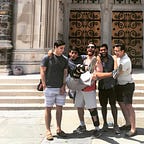Novel (Nobel) Self Experimentation
9–13–16, Adil
The 2005 Nobel Prize in Physiology or Medicine was awarded to Barry Marshall, an Australian doc with a funky story.
His father managed chicken factories in Perth, and his mother was a nurse. He was a B’s and C’s student in high school, but says he must’ve done well on the med school admissions test and had charisma in the interview because he wound up in medicine. He just aspired to be a general practitioner.
Before the 20th century, nobody took stomach ulcers seriously. Up until Marshall’s work, all doctors would just say that the pain was caused by stress. This was a serious disease, though: in this day and age, several people got so sick that they had their stomachs removed or bled until they died. Ulcers were painful; when you eat food, it temporarily washes the acid away, but with a duodenal ulcer (ulcer with a hole in it), the acid comes back and irritates the raw base of the ulcer, causing pain to start back up. These problems were apparently so common that the Mayo Clinic was built on gastric surgery. After cutting out part of the stomach and connecting it to the intestine, about half of people felt better, but about 25% of these “cured” patients became “gasrtic cripples,” lacking appetite and never regaining complete health.
Working with an older pathologist who later shared the Nobel, Marshall noticed that a bacteria kept showing up in the biopsies of all these patients with stomach issues. He got really interested in this, and began scrutinizing the biopsies of every patient who walked through the door. This bacteria was the now-famous Helicobacter pylori. He was finally able to look at 13 patients with duodenal ulcer, and found that each one had this H. pylori bacteria.
After writing their full paper, they were still met with huge skepticism. Nobody wanted to believe them, especially 2 groups: 1) drug companies who had a $3 billion/year industry on antacids and 2) gastroenterologists (GEs) who did endoscopy as a bread-and-butter procedure, and if these bacteria findings were true, a huge chunk of their patients get handed over to the infectious disease (ID) docs. So the GEs hated him but the ID guys loved him.
The next step was to get solid experimental (not observational) proof. He kept failing to infect animals: pigs, rats, mice — they all flubbed. He couldn’t ethically convince any humans to do it. So what does he do? He sees one of his patients with gastritis, cultures his bacteria in a petri dish, then drinks the bacteria himself.F
He had taken a baseline endoscopy of himself before chugging the bacteria. He thought maybe years later he’d develop an ulcer, but surprisingly just 3 days later, he started developing nausea and bad breath, noticed only by his mother. On days 5–8, he had no-acid vomiting, and on day 8 a repeat endoscopy showed massive inflammation (gastritis) all over, and indeed H. pylori showed up in a biopsy from this area. On day 14, after a third endoscopy, Marshall began taking antibiotics. The problems cleared up soon.
He published his findings in 1985, but still, the medical community didn’t buy it. Finally, in the US, the NIH and FDA took note and fast-tracked a lot of clinical trials that unequivocally proved Marshall right. It went pretty quickly after that: between 1993–1996, the whole country changed its mentality. We now know that H. pylori is the primary cause of gastritis, ulcers, and stomach cancer, and patients don’t get their stomachs chopped out while stupidly taking antacids instead of antibiotics. And voila, 2005 Nobel Prize.
